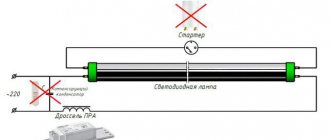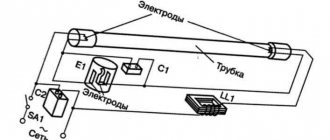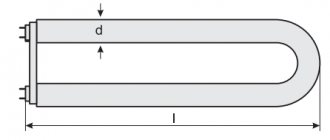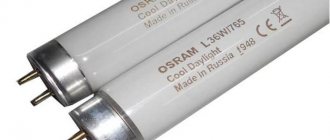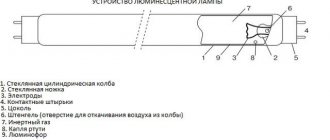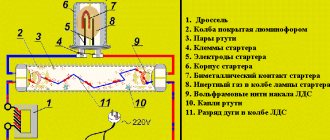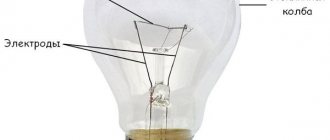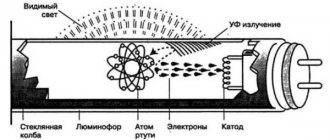Disposal of fluorescent lamps should become a mandatory procedure for every person and any organization. Since they will be safe only as long as the structure maintains its integrity.
The reason for this is the presence of mercury vapor in their flasks, which, even with short-term contact, can cause serious, and sometimes irreparable, damage to human health, water, and soil.
In this material we will tell you why recycling of fluorescent lamps is needed, where to dispose of used devices and how to dispose of them.
Why is recycling necessary?
The design of each fluorescent lighting fixture contains up to 7 milligrams of mercury. At first glance, this is not enough. For example, in any thermometer there is ten times more of this substance.
But the peculiarity is that just a few grams of mercury vapor have a 16 times larger contact patch with the surrounding air than several kilograms of the same metal in a liquid state.
As a result, the contents of the flask saturate up to 50 cubic meters of space with poison and the permissible norm will be exceeded 160 times.
All fluorescent lamps contain mercury, which when exposed to electricity provides effective lighting. But when they use up their resources, people are faced with the problem of disposal. Which is aggravated by the fact that until recently such products were sold in hundreds of millions
Therefore, in the event of depressurization of a fluorescent lamp of any manufacturer in the room, a situation is created that belongs to the first group of danger.
That is, the highest, since even a short exposure can cause serious damage to the cardiovascular, immune, nervous systems, gastrointestinal tract, visual organs, and skin.
In addition, mercury can quickly accumulate in the human body, resulting in long-term exposure. No less dangerous are fluorescent lamps thrown into common garbage disposals in apartment buildings or in the private sector.
In this case, microorganisms actively influence mercury vapor, as a result they turn into an easily soluble and very stable compound (methylmercury), capable of poisoning hectares of water and soil for decades.
Most people understand the troubles caused by damage to a mercury-containing thermometer. And depressurization of a lamp can cause damage to health on a much greater scale, which necessitates disposal
The problem is complicated by the fact that until recently hundreds of millions of fluorescent lamps were sold annually in the post-Soviet territory. Which are now beginning to develop their resource.
Hazard Control Measures
Mechanical cleaning
To ensure safe operation of the room in which the energy-saving lamp was broken, it is necessary to carry out a set of measures to clean it from vapors and mechanical residues of the product:
A responsible adult must take on the job of cleaning the apartment or premises. Everyone else needs to leave the affected area, taking their pets with them. To avoid the spread of contaminated air, the door of the room is tightly closed, and to reduce the concentration of toxic substances, windows, vents and a balcony (if there is one) are opened wide. The next step is to clean up the parts and shards of the lamp.
It is extremely important to avoid contact with fragments and particles of the flask with bare hands - work is carried out exclusively with latex or rubber gloves. To collect the fragments, it is better to take a kitchen sponge, towel, rag, cardboard or paper.
It is better not to use a vacuum cleaner or any other valuable items, because they will have to be disposed of after cleaning. The collected fragments must be placed in a bag made of dense material. It should be fastened and ensure tight storage. The surface on which the fragments were located is wiped with a damp towel. It is also sent in a sealed bag, where the fragments were poured. If lamp particles fall on furniture, pillows or other soft household items, they should also be placed in sealed bags. In the future, it is necessary to conduct an examination for the content of harmful metals in order to understand whether you can continue to use them or throw them away. If splinters are scattered on the carpet, it should be taken outside and thoroughly beaten out. The blows must be applied to the reverse surface. In this case, the surface under the knockout platform should be lined with an old oilcloth, sheet, tablecloth or blanket. The fragments are hazardous to the environment, so they must be collected in this way for further disposal. After beating, the carpet should be ventilated for a long time, reducing the concentration of toxic substances.
At this stage, measures have been taken to mechanically clean the premises. All fragments and the materials with which they were collected must be disposed of in a special container, which must be installed in each populated area. Throwing mercury waste into ordinary trash cans worsens the environment and increases the risk of injury to people and animals.
Demercurization
After mechanical cleaning, the room in which the energy-saving light bulb has broken must be demercurized. This means neutralizing mercury compounds and vapors. The procedure involves cleaning the room using special solutions. You can prepare them at home using one of the following recipes:
- dissolve 2 grams of potassium permanganate in 1 liter of water;
- dissolve 400 grams of soda and soap solution in a 10-liter bucket of water. A chlorine-containing product like “Belizna” is suitable as a replacement for soda;
- Dissolve 100 ml of iodine in 1 liter of water. This option is more suitable for objects with a large affected area.
The resulting mixtures are used to treat surfaces in the room where the accident occurred. Particular care should be taken to wipe hidden cavities and hard-to-reach areas such as cracks between floorboards. It is recommended to keep the solution on the surface for several hours, and carry out the mercury neutralization procedure daily for 3-4 days. Naturally, to maintain health, you need to protect your hands with rubber gloves.
If a fluorescent lamp breaks, after disposing of the fragments, you can contact a company that does this professionally for demercurization services. Moreover, specialists will use special means for treatment that are more effective in neutralization. In addition, such companies help measure the concentration of mercury vapor in the air after treatment and determine whether objects that were exposed to fragments after a lamp rupture are suitable for use.
User input into the recycling process
Theoretically, this operation does not pose any difficulties. So, all a person needs is to perform a few simple actions in a certain order.
Which are the following:
- A burnt-out fluorescent lamp must be packaged in a complete plastic bag. Which will prevent mercury poisoning in the event of unexpected depressurization during the disposal procedure.
- Take the device to a collection point.
It should be remembered that the dismantling, transportation, and storage of a used lighting device cannot be treated negligently. For example, placing it in a regular trash bag or leaving it in another place where accidental damage may occur.
After completing all of the above, the owner’s mission will be considered completed. But in practice everything is more complicated, the reason for this is the insufficient number of places intended for collecting fluorescent lamps.
The disposal procedure is lengthy and labor-intensive. But the main and only task of the owner of used fluorescent lamps is to hand them over to a collection point. Why do you need to find a container similar to the one shown in the photo?
According to the governing documents of almost all countries in the post-Soviet space, the collection of unusable lighting fixtures containing mercury should be handled by the management of apartment buildings. These include residents' associations, management organizations, and also such responsibilities are assigned to housing and housing departments and REUs.
For example, in Moscow, absolutely all housing maintenance offices are equipped with the necessary equipment for collection and are serviced by trained specialists.
But the majority of the country’s housing and communal services managers, for various reasons, ignore such requirements, so these items are quite rare in a number of regions. But they exist, at least in all major cities.
And to find the nearest one, it’s enough:
- use the Internet;
- call back to the management organization, housing office, Ministry of Emergency Situations.
Often, officials are helped out by commercial organizations and collection points for all kinds of mercury-containing lamps are created in retail chain stores, and often even at battery collection points. For example, in Russia they are available in many IKEA supermarkets.
In addition, concerned citizens can call on the management of housing and communal services in writing to fulfill their duties. Moreover, equipping the point is a simple procedure. Because all you need to do is install a small, durable container.
If there is no specially equipped container nearby, then citizens have the right to apply in writing to the housing office or management company with a request to acquire one. Moreover, it is allowed to use all kinds of containers as a collection that can prevent depressurization of mercury-containing flasks
And the reception can be carried out by full-time electricians of housing and communal services, management companies, who subsequently transfer the devices that have served their purpose for recycling, which is convenient for residents.
In addition, such an order is not difficult to organize, since special skills or any special tools are not required for this.
It is definitely worth remembering that at lamp collection points, responsible persons will only accept sealed products, that is, intact ones with no signs of damage.
If they are in unusable condition, they should not be transported or attempted to be disposed of. Because it can be dangerous to health. In view of this feature, when the lamp in the room has depressurized, it is better to call representatives of the Ministry of Emergency Situations.
You also need to know that all products that have not reached the warranty period can be returned to the selling organization. In such cases, there is even the possibility of a refund or replacement.
The duration of the warranty period can be up to 2 years; sometimes you can find out the exact information by studying the data indicated on the packaging.
Organizations and reception points in major cities
To solve the problem of recycling mercury devices, it is necessary to find out where to dispose of such waste. In large cities there are many companies and organizations that will get rid of high-risk waste.
In large cities, recycling is carried out by the following organizations:
- Moscow (“Mercom”, “Inter Green”, “NPEF EkON”)
- Novosibirsk (“SibRtut”)
- St. Petersburg (“First environmental service”)
- Ekaterinburg (“Spetsavtokom”)
- Chelyabinsk (“Voir”, “Meriz”)
- Rostov-on-Don (“Don Ecology Fund”, “Eco-Spas Bataysk”, “Technoecologist”)
In Russian cities there are special collection points where you can take the lamp yourself for subsequent neutralization. In large populated areas there are eco-mobiles - vehicles that move along a given route. Cars are equipped with special containers for collecting hazardous waste: lamps, batteries, accumulators, waste electronics.
What if the collection point is far away?
It often happens that a fluorescent lamp has exhausted its intended life, so it needs to be disposed of, but the collection point is not close and it is not profitable to go there, and there is no desire to simply throw it away.
In many cases, the collection of mercury-containing devices is carried out by full-time electricians of management companies and housing and communal services. And transportation to processing sites is carried out by specialized companies that provide services on a contractual basis.
In the situation described, a person can simply pack the flask in a whole plastic bag and put it in some kind of durable container.
Which can be any rigid container that can prevent depressurization of the lighting device due to careless handling. Next, it must be placed in a place that children and animals cannot reach.
The lamp can be stored in this way for a long period, but still, it should not exceed six months. And the specified time is quite enough to find a convenient way to deliver the lamp to the collection point.
Owners of burnt-out mercury-containing lamps should remember that in this way, as shown in the photo, it is not worth solving the problem. And the point is not even in possible sanctions, but in the fact that mercury that gets into the ground can affect its condition and water for decades
In addition, many large cities have commercial organizations that dispose of mercury-containing products. The specialists of which carry out the collection, and they arrive at the right place when called. But in most cases you have to pay for such a service.
As a result, it can only be beneficial to large enterprises that have to solve the problem of dozens or hundreds of burnt out lamps.
How to conclude a service agreement?
An agreement for the removal and disposal of fluorescent lamps with PromWaste Group of Companies is easy to complete. Fill out a request using the feedback form on the website or contact us by phone
Our employee will clarify the necessary initial data and conditions for the work, send a commercial proposal and a standard contract form. After agreeing and signing the contract, we will issue an application for the removal and disposal of fluorescent lamps. We will agree on a date for completing the work. We transport the lamps for their further neutralization. We will provide a complete set of financial and environmental documentation. We take care of our clients, and they trust us. The PromWaste group of companies cooperates with dozens of large organizations. In our work with clients, we are based on compliance with environmental and legal standards when removing, neutralizing and recycling hazardous waste, and providing a high-quality level of services.
Leave a request for feedback - we will contact you promptly and help you order a service from us at the best price.
Disposal of a damaged lamp
No one can be immune from any unpleasant accidents. Therefore, it is always necessary to remember that sometimes it is necessary to get rid of a burnt-out device urgently and you need to be prepared for this. After all, efficiency determines whether damage will be caused to health or the environment.
Safety precautions for product damage
So, if a fluorescent lamp that illuminated a room was broken or damaged, then a person, in order to avoid poisoning, needs to take prompt measures.
Which include:
- evacuation of people and animals;
- ventilation of the room;
- cleaning up the remains of the flask;
- calling representatives of the Ministry of Emergency Situations.
It should be remembered that evacuation must be carried out immediately after detecting damage to the fluorescent lamp. At the same time, there is no need to run headlong somewhere, just go to the next room.
If representatives of any enterprise decide to carry out “disposal” as shown in the photo, then a criminal case will be opened. The reason is that it can cause more than significant harm to people living nearby
The room itself where the depressurized lamp is located must be insulated, that is, the doors must be tightly closed. If they are not there, then you should use fabric or other available material. And only after that open the windows for ventilation.
The procedure should be exactly in the described order due to the fact that when a draft ventilates the entire apartment, there is a high probability that significant accumulations of mercury vapor will spread throughout its entire area, and some of them will accumulate in “dead zones” and can affect health residents.
Insulating the room will also help prevent broken glass and accumulated substances from spreading to other rooms.
The disposal procedure, or in other words recycling, of mercury-containing lamps can only be carried out by licensed organizations with special equipment and trained specialists
The duration of ventilation should be at least 20-30 minutes. During this time, the bulk of the mercury vapor will evaporate and people will be able to clean up. Why should the respiratory tract be protected with a cotton-gauze bandage or simply a damp cloth?
For work, you can use two pieces of thick cardboard. One of them will serve as a dustpan for a person, and the second should be used as a broom, raking up the remains of broken structural elements.
You should not help yourself with unprotected hands, as mercury particles easily penetrate through the pores of the skin. Which can lead to serious poisoning in a matter of minutes.
If parts of a broken lighting fixture fall on the carpet or soft children's toys, they should be hung outside for thorough ventilation. The duration of which should be several hours.
After which all of the listed things can be used in everyday life without any additional processing. Since after the mercury vapor has evaporated, it will become absolutely safe.
Recycling of mercury-containing lighting devices is carried out using special installations - demercurizers or vacuum traps. In any of the cases, all mercury is collected and sent to production in a liquid state for new use.
The collected glass cullet should not be thrown away anywhere; it is better to pack it in cellophane, a tightly closed container, or any other container. Next, the remains of the fluorescent lamp should be handed over to the Ministry of Emergency Situations, who must be called.
Even if the owners of the premises successfully cope with the liquidation of the consequences on their own, the presence of rescuers is necessary so that they check the suitability of the housing or any other premises for the presence of people there.
And if necessary, surfaces in contact with mercury can be treated with special solutions, which will finally eliminate the danger to human health.
All of the listed actions after depressurization of any fluorescent lamp must be carried out without fail, and residents should not be reassured by the absence of any signs of danger.
Since mercury vapor has no color or odor, which means that without special equipment their presence cannot be detected. Although for a short time the concentration of the substance in the room where the lamp is broken will exceed the permitted limit by tens, or even one and a half hundred times.
How is recycling carried out by specialists?
Handing over fluorescent lamps to a collection point is only the first stage of recycling. Since this is a rather lengthy and complex operation that can only be performed with the help of special equipment.
If citizens who use mercury-containing lamps acquire kits for household demercurization, then this will be the right decision. Since they do not cause harm to health and will quickly help eliminate the consequences of depressurization of the flask in the room. Moreover, their cost is moderate
The next stage of recycling is the cutting of lighting fixtures, which is done using a device called a demercurizer. Where they are crushed into small elements in order to release all mercury particles.
Which are then bound by a sorbent and enter the condenser, where they precipitate and turn into liquid metal. The final stage is to send it to enterprises for further use.
Another type of processing used allows the vapors to be frozen in a vacuum chamber. This also makes it possible to obtain liquid metal, exactly the same as is used in thermometers. Further it can also be used in industry.
In addition, an important task during recycling is the separation of several grams of phosphor - this amount is contained in each fluorescent lamp. Although it is less harmful than mercury, it still poses a danger. Therefore, it is subject to mandatory burial.
If it happens that a mercury-containing lamp breaks, then first of all it is necessary to evacuate people from the room, and then ventilate it. The final stage will be cleaning the cullet, which must be done with rubber gloves and a cotton-gauze bandage and a respirator.
But even waste lamps pose some danger to people. And to level out this factor, the phosphor and other parts, during transportation to processing sites, are packaged in sealed containers and sprinkled with cement, which is capable of binding the remaining mercury vapor.
Our website contains material on the topic: why and how to replace fluorescent lamps with LED ones. We recommend reading it too. Read on for more details.
An energy-saving lamp in an apartment is broken - what to do?
You need to act clearly and in a strictly defined order. This will give you the opportunity to protect yourself and your loved ones as much as possible.
Stage 1
Entrust the disposal of the lamp to the most careful and conscientious person. The rest of the room has nothing to do. No need to inhale toxic fumes. You shouldn’t interfere with advice, fuss and worries either.
Stage 2
Close the door to the room to prevent mercury vapor from penetrating into other areas of the apartment. Open the window. By ventilating the room, you reduce the concentration of harmful substances in the atmosphere of the room. This minimizes the harmful effects of the poison on the body.
Stage 3
This is, in fact, the collection of fragments for further disposal:
- Do not touch the fragments with unprotected hands! Be sure to use protective rubber gloves.
- It is advisable to collect waste using paper or cardboard sheets. You can use an old sponge or paper towel. In a word, you need to use items that you won’t mind throwing away. Do not collect the fragments with a vacuum cleaner.
- Collected waste must be placed in a sealed ziplock bag.
- After cleaning is completed, the area where the lamp was located should be wiped with damp textiles. The rag should also be placed in the bag where the remains of the broken lamp are located. The bag should only be disposed of in a special container for devices containing mercury.
Conclusions and useful video on the topic
A video about the dangers of mercury-containing lamps and how to properly get rid of them when the resource is exhausted:
The following video shows how sealed flasks containing harmful vapors are recycled:
The recycling procedure for ordinary citizens and organizations consists of transferring burnt-out fluorescent lamps to equipped collection points. This is not always convenient, and businesses generally have to pay, but it is necessary to do it. Since failure to comply with the requirements leads to a significant negative impact on the environment, and therefore on human health.
If you have any questions about the topic of the article, please leave comments in the block below. There you can share your experience and give practical advice to visitors to our site.
How are sodium lamps disposed of?
Self-disposal of sodium lamps is prohibited by current legislation. Despite a number of advantages, these lamps can harm the environment. The energy efficiency of the device is explained by the content of sodium vapor in combination with mercury. Therefore, spent sodium lamps are classified as hazard class 1.
Disposal is limited to hazardous substances contained under the device body. In this case, technological methods are used to prevent gas from entering the atmosphere. Strict requirements are also imposed on other circulation processes. When operating sodium lamps, several rules must be followed to prevent damage and leakage of hazardous substances.
Dangerous filler
Energy-saving varieties operate on mercury vapor. Each lamp contains about 5 mg of a dangerous component, which can cause serious poisoning if the lighting device breaks and the substance gets into the air or open ground.
Consumers should know that every energy-saving product purchased in a store comes with a warranty. If the lamp has lasted less than 6–12 months, it can be exchanged for a new one. The seller must present a receipt and a box with the production date. Has the lamp worked as expected and burned out? You will have to look for companies that dispose of such waste.
Why can't the lamp be thrown away with the rest of the trash? Fragile glass may break upon impact, and then mercury vapor will begin to seep into the ground and float in the air. People, including owners, who will walk near the house will have to breathe a dangerous substance. Mercury poisons the human body: the functioning of the digestive organs and respiratory system is disrupted, the kidneys and heart suffer. A few broken lamps are enough to end up in the hospital with serious intoxication. Children and animals are more sensitive to mercury fumes, for whom 1–2 mg of the substance is enough to become poisoned.
